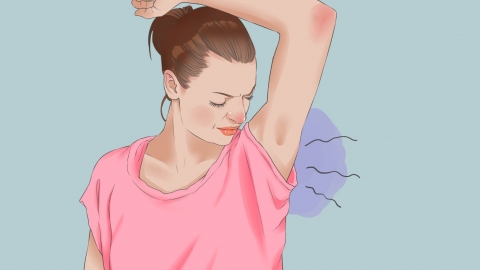What causes axillary osmidrosis (smelly armpits)?
Body odor usually refers to axillary bromhidrosis. Generally, axillary bromhidrosis may be caused by genetic factors, hormonal changes during puberty, axillary eczema, axillary folliculitis, infected axillary sebaceous cysts, and other reasons. It is recommended to seek timely medical advice, identify the cause, and receive symptomatic treatment under a doctor's guidance. Detailed analysis is as follows:

1. Genetic factors: The structure and secretory function of the axillary apocrine glands are influenced by genetics. The sweat contains higher levels of fatty acids and proteins, which are easily decomposed by bacteria to produce odor. It is important to maintain axillary cleanliness, wash daily with warm water, and wear loose, breathable cotton clothing.
2. Hormonal changes during puberty: Increased androgen levels during puberty stimulate the development and maturation of axillary apocrine glands, increasing sweat production and intensifying odor. Regularly trimming underarm hair can reduce bacterial adhesion, and strenuous exercise should be avoided to minimize sweating.
3. Axillary eczema: Prolonged dampness, friction, or allergen exposure in the axilla can trigger eczema. Skin barrier damage makes it easier for bacteria to proliferate, worsening odor, often accompanied by itching, erythema, and papules. Patients can follow medical advice to use medications such as desonide cream, mometasone furoate cream, or hydrocortisone butyrate cream to alleviate inflammation and itching.
4. Axillary folliculitis: Bacterial infection causes inflammation of the axillary hair follicles. Follicular secretions increase and easily mix with sweat, producing odor. Symptoms include follicular redness, pain, or pustules. Patients should follow medical advice to use clindamycin gel, compound polymyxin B ointment, or fusidic acid cream to inhibit bacterial infection.
5. Infected axillary sebaceous cyst: Blockage of axillary sebaceous gland ducts forms a cyst, which secondarily becomes infected with bacteria. The cyst contents mix with sweat, causing foul odor, accompanied by local redness and pain. The cyst and surrounding diseased tissue can be surgically removed via sebaceous cyst excision, eliminating the basis for odor production at its source.
In daily life, avoid consuming spicy and irritating foods, reduce tobacco and alcohol intake, and avoid emotional stress that increases perspiration. Change clothes regularly, choose mild and non-irritating cleansing products, and avoid excessive cleaning that may damage the axillary skin barrier.




